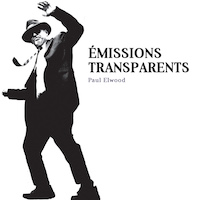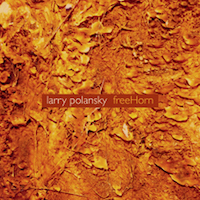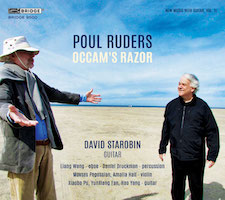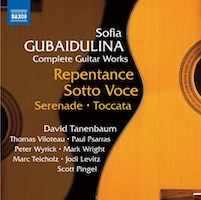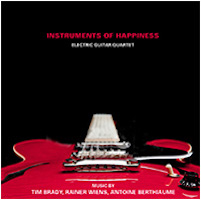String Theory 34: Many Guitars and a Banjo
|
Grant Chu Covell [December 2020.]
“Émissions Transparents.” Paul ELWOOD: Émissions Transparents (2016)1; For Arthur S. Wolff: London Improvisation 4A and 4B (2016)2; Plutonic Winds (2015)3; Ashe County Lament (2008)4. Christian WOLFF: Banjo Player (2015)5. The Callithumpian Consort1: Pablo Cano-Gomez (e-guit), Yukiko Takagi (pno), Jacob Mason (mellotron), Mike Williams (perc), Stephen Marotto (vlc), Ross Wrightman (electronics), Stephen Drury (cond.), Paul Elwood2,5 (banjo), Eddie Prévost2 (perc), Aly Olson3 (sop), Kelvin Tran3 (celeste), The University of Iowa Percussion Ensemble3: Christine Auspurger, Andrew Veit, Ben Yancey, Wannapha Yannavut (perc), Daniel Moore (cond.), Rose Chancler4 (pno), Cary Fridley4 (voice). Innova 005 (1 CD) (www.innova.mu). Comfortably unclassifiable, Elwood’s improvisations and pieces explore the banjo and its tropes. The music we may traditionally associate with the banjo is lovingly distorted in Ashe County Lament which combines a live piano solo with a pre-recorded tape of Cary Fridley singing the traditional tune “The Girl I Left Behind.” In Wolff’s brief solo opus, Banjo Player, forlorn riffs hesitate and stumble. Elwood and Wolff have improvised together. Presumably this piece is fully notated, including the part requiring a bow. A different Wolff (Christian appears to be no relation to Arthur) is celebrated in the London Improvisations, provided in two parts with different pieces intervening. The banjo elicits eerie rasps complemented by whirring metal percussion. The larger ensembles travel elsewhere. The five-part Émissions Transparents for fronting guitar with small ensemble including electronics and tape concerns humankind’s communication with “the other side.” Moments suggest Messiaen, and the tape part unexpectedly includes snatches from the July 1969 moon landing. The Albert Goldbarth setting is meant to capture Kansas (Elwood was born and raised there, Goldbarth teaches in Wichita); the “Plutonic Winds” combined with the percussion sounds summon old black-and-white sci-fi TV serials.
“freeHorn.” Larry POLANSKY: freeHorn (2016)1; ii-v-i (1997)2; minmaj (2013; arr. of Carl RUGGLES’ Angels, 1921)3. David Kant1 (t-sax, computer), Krystyna Bobrowski1 (hrn), Tom Dambly1 (trpt), Amy Beal1 (pno), Giacomo Fiore1,2,3 (e-guit), Larry Polansky1,2,3 (e-guit, fretless e-guit), David Dunn1 (e-vln), Monica Scott1 (vlc). Cold Blue Music CD0049 (1 CD) (www.coldbluemusic.com). This is a charming but modest release reflecting Polansky’s fascination with canons, alternate tunings and the guitar. The ensemble-plus-electronics chamber work freeHorn is a grand schmear of wriggling harmonies: It could be a penetrating examination of Das Rheingold’s opening (because we hear a horn and overtones) or a slow buzzing frolic generated with electric guitars and friends: “Only open strings, 2nd, 3rd and 4th harmonics, and notes stopped at the 7th and 12th frets are used, and the guitars are audibly retuned from one ‘section’ to another.” ii-v-i and minmaj are duets for electric guitars. ii-v-i requires precisely considered natural intonation tuning, the same as used in freeHorn, but the duet offers eight minutes of happy bouncing unlike the octet’s staid 20. minmaj is an arrangement of Carl Ruggles’ Angels (1921). Ruggles’ gritty harmonies are transformed into a glowing three-minute carol, a quirky holiday greeting.
“New Music with Guitar, Vol. 11, Poul Ruders: Occam’s Razor.” Poul RUDERS: Simple, Stealthy, Romantic, Rocking, Gentle and Nimble from Pages (2008-10)1; Cantus Firmus Nos. 2 and 3 from Three for Two (2016)2; Occam’s Razor (2013)3; Air with Changes (2018)4; New Rochelle Suite (2003-06)5; Schrödinger’s Cat (2012)6. Liang Wang3 (ob), David Starobin1,2,3,4,5,6, Xiaobo Pu4, YunXiang Fan4, Hao Yang4 (guit), Daniel Druckman5 (perc), Movses Pogossian2, Amalia Hall6 (vln). Bridge Records 9500 (1 CD) (www.bridgerecords.com). Bridge proffers a generous candy bowl of Ruders’ guitar miniatures. The composer and guitarist’s collaboration flourished after a first meeting at Tanglewood in 1986, and resulted in such elegant works as the Second Guitar Concerto, a sequence of enthralling variations on Paganini’s 24th Caprice. The largest ensemble here is a guitar quartet, the sedate Air with Changes, an arrangement of variations on a Danish tune, Harpens Kraft (“The Power of the Harp”) originally for, yes, harp. Most of the pieces are multi-movement duets: Occam’s Razor (with oboe), New Rochelle Suite (with percussion), and Schrödinger’s Cat and two parts of Three for Two (with violin). Ruders gracefully sports different hats, most evidently in the New Rochelle Suite which includes dance movements, underscored by characteristic percussion (snares, tambourine, castanets, triangle, whip, etc.) and an unexpected owl call. The philosophical pieces are the most sustaining. Occam’s Razor concludes with a quiet dissection of four pitches. Schrödinger’s Cat presents twelve canons. Sometimes strict, sometimes not, the pieces’ simplicity mask that the duet may be precisely one beat apart or flying along at different rates.
“Gubaidulina: Complete Guitar Works.” Sofia GUBAIDULINA: Repentance (2008)1; Serenade (1960)2; Toccata (1969)3; Sotto Voce (2010; rev. 2013)4. David Tanenbaum1,2,3,4, Thomas Viloteau1, Paul Psarras1, Marc Teicholz4 (guit), Jodi Levitz4 (vla), Peter Wyrick1 (vlc), Mark Wright1, Scott Pingel4 (cbs). Naxos 8.573379 (1 CD) (www.naxos.com). Two of Gubaidulina’s craggy monuments surround an itty classical pair. The single-sheet Serenade could be a frank fantasy on a flamenco wisp, while the Toccata (premiered here) maintains a tacking pulse. Both Repentance and Sotto Voce are large labors (25 minutes each). Repentance asks for three guitars, cello and bass, though the work often treats the cello as a soloist. Sotto Voce is a quartet for two guitars, viola and bass. Both pieces employ extended techniques which must be delivered enthusiastically without slipping into parody. Sotto Voce conceals subtle sounds of a drinking glass being rubbed against the guitar strings. Repentance demands a gadget Gubaidulina calls a “friction beater,” a rubber or plastic ball attached to a spring or piano string. Tanenbaum provides the right level of intensity, but I wish the upper strings, the cello in Repentance and the viola in Sotto Voce, found more recklessness and ferocity.
“Instruments of Happiness.” Tim BRADY: The Same River Twice: Symphony #5.0 (2013); The Same River Twice: Symphony #5.Solo (2014). Antoine BERTHIAUME: Fungi (2013). Rainer WIENS: What is Time? (2013). Instruments of Happiness: Tim Brady, Gary Schwartz, Michel Héroux, Antoine Berthiaume (e-guit). Starkland ST-224 (1 CD) (www.starkland.com). As a quartet of electric guitars, Brady’s curiously titled Fifth Symphony, offers an encyclopedia of sounds, from rapid fingered passages, to overtone clouds triggered by effects pedals, e-bows and slides. There’s even a message addressed to the audience where a cadenza might be expected. A second version of the Fifth for solo guitar with electronics is different, standing like a purely electroacoustic work. Like a chaconne, Fungi works with the same chord progression for its nine minutes. For this instance of What is Time? Brady mixed two studio recordings. If Fungi was an ensemble of guitars playing in rhythm, What is Time? continues to explore the guitars’ potential as in Brady’s solo Fifth.
[More Grant Chu Covell, String Theory]
[Previous Article:
Concerto Concentrations 5: “Beethoven’s World”]
[Next Article:
Used Bin Troll Tweets UU.]
|
